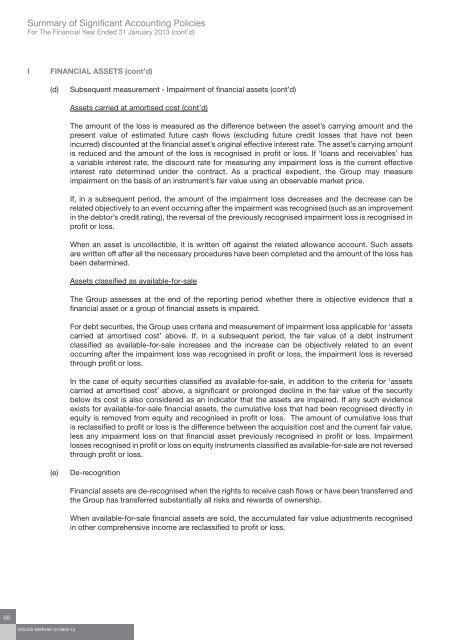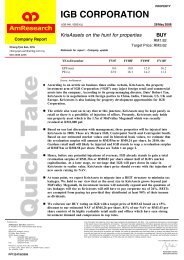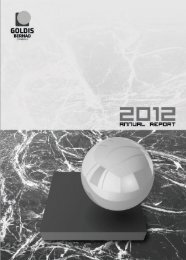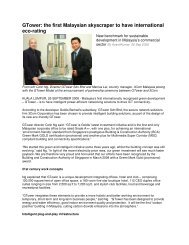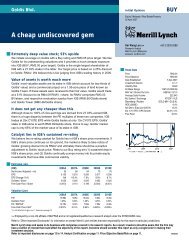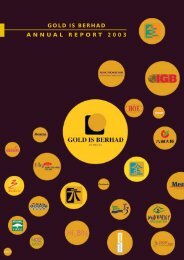Goldis Berhad Annual Report 2013
Goldis Berhad Annual Report 2013
Goldis Berhad Annual Report 2013
Create successful ePaper yourself
Turn your PDF publications into a flip-book with our unique Google optimized e-Paper software.
Summary of Significant Accounting Policies<br />
For The Financial Year Ended 31 January <strong>2013</strong> (cont’d)<br />
I<br />
FINANCIAL ASSETS (cont’d)<br />
(d)<br />
Subsequent measurement - Impairment of financial assets (cont’d)<br />
Assets carried at amortised cost (cont’d)<br />
The amount of the loss is measured as the difference between the asset’s carrying amount and the<br />
present value of estimated future cash flows (excluding future credit losses that have not been<br />
incurred) discounted at the financial asset’s original effective interest rate. The asset’s carrying amount<br />
is reduced and the amount of the loss is recognised in profit or loss. If ‘loans and receivables’ has<br />
a variable interest rate, the discount rate for measuring any impairment loss is the current effective<br />
interest rate determined under the contract. As a practical expedient, the Group may measure<br />
impairment on the basis of an instrument’s fair value using an observable market price.<br />
If, in a subsequent period, the amount of the impairment loss decreases and the decrease can be<br />
related objectively to an event occurring after the impairment was recognised (such as an improvement<br />
in the debtor’s credit rating), the reversal of the previously recognised impairment loss is recognised in<br />
profit or loss.<br />
When an asset is uncollectible, it is written off against the related allowance account. Such assets<br />
are written off after all the necessary procedures have been completed and the amount of the loss has<br />
been determined.<br />
Assets classified as available-for-sale<br />
The Group assesses at the end of the reporting period whether there is objective evidence that a<br />
financial asset or a group of financial assets is impaired.<br />
For debt securities, the Group uses criteria and measurement of impairment loss applicable for ‘assets<br />
carried at amortised cost’ above. If, in a subsequent period, the fair value of a debt instrument<br />
classified as available-for-sale increases and the increase can be objectively related to an event<br />
occurring after the impairment loss was recognised in profit or loss, the impairment loss is reversed<br />
through profit or loss.<br />
In the case of equity securities classified as available-for-sale, in addition to the criteria for ‘assets<br />
carried at amortised cost’ above, a significant or prolonged decline in the fair value of the security<br />
below its cost is also considered as an indicator that the assets are impaired. If any such evidence<br />
exists for available-for-sale financial assets, the cumulative loss that had been recognised directly in<br />
equity is removed from equity and recognised in profit or loss. The amount of cumulative loss that<br />
is reclassified to profit or loss is the difference between the acquisition cost and the current fair value,<br />
less any impairment loss on that financial asset previously recognised in profit or loss. Impairment<br />
losses recognised in profit or loss on equity instruments classified as available-for-sale are not reversed<br />
through profit or loss.<br />
(e)<br />
De-recognition<br />
Financial assets are de-recognised when the rights to receive cash flows or have been transferred and<br />
the Group has transferred substantially all risks and rewards of ownership.<br />
When available-for-sale financial assets are sold, the accumulated fair value adjustments recognised<br />
in other comprehensive income are reclassified to profit or loss.<br />
68<br />
GOLDIS BERHAD (515802-U)


